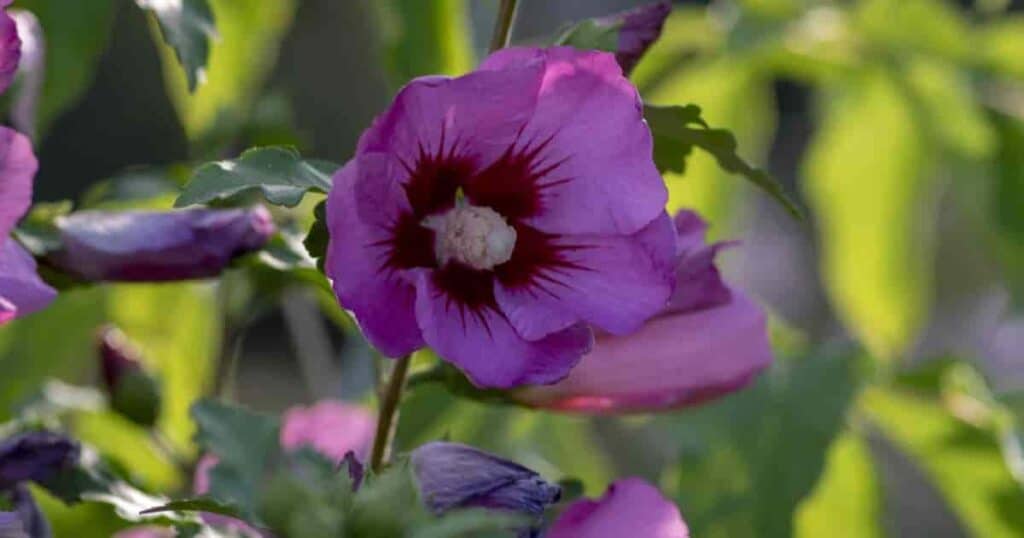The Rose of Sharon (Hibiscus syriacus) is known as “Althea.” It is one of the wide varieties of Hibiscus (Hibiscus rosa-Sinensis). It is a member of a vast genus of plants that may be tropical, perennial, or deciduous.
Hibiscus, in general, are often referred to by the common names Rose of China or Chinese Hibiscus. The flowers and foliage of H. syriacus and H. rosa-sinensis look quite similar, but there are many differences in the hardiness levels and ideal settings for each.

In this article, we will discuss those differences and explain the uses of the Rose of Sharon and Chinese Hibiscus. Read on to learn more.
Hibiscus Belong To The Mallow Family Of Plants
There are nearly 250 genera and more than 4000 species within the Malvaceae (mallow) family of plants. The various members grow wild in most tropical settings. However, they are not naturally occurring in cold climates.
Others in this family include:
- Poppy mallow
- Marshmallow
- Indian mallow
- Wax mallow
- Hollyhock
- Cotton
- Okra
Rose of Sharon and Chinese Hibiscus both come from Asia but need different climate conditions.
South Korea’s Rose of Sharon is called Mugunghwa, the national flower. In Malaysia, the Rose of China is called Raya Bunga, the national flower.
Even so, the most notable difference between Rose of Sharon and Chinese Hibiscus, in general, is that they are hardy in different climates.
Hardy Hibiscus Is A Rugged Survivor
Rose of Sharon is a hardy or woody hibiscus that can thrive in various settings. It can tolerate fairly cold winters, polluted air, soil and light conditions, and many other challenges.
In fact, this plant can become a nuisance because it tends to thrive, survive and self-sow its seed hither, thither, and yon.
These beautiful and enthusiastic shrubs grow to about 12′ feet and can attain a 10-foot spread. They bloom profusely late in the summer and into the autumn.
Blooms last a day but replace themselves as quickly as they mature and go to seed, so blooming is relatively continuous for several weeks.
Althea is a bit slow to start in areas with freezing winters, and the blooming season is a bit shorter.
In these settings, it will tend to get leggy as the growing season progresses, but it can be vigorously pruned to correct this problem and should be cut back to the ground for winter.
Rose of Sharon is a good choice as a landscape plant that will quickly provide an attractive summertime privacy hedge with many hummingbirds, butterflies, bees, and general pollinator appeal.
Tropical Hibiscus Is A Bit Of A Diva
Hibiscus rosa-sinensis (Chinese Hibiscus) is a tropical plant that is only winter hardy in USDA hardiness zones 9 through 11. In other climates, it can be grown as a container plant and brought indoors for the winter.
Because of its lack of winter hardiness, it will not self-sow outside of tropical settings, so it does not tend to become a nuisance.
Where Rose of Sharon is a highly carefree plant, Chinese Hibiscus is rather picky and requires a bit more maintenance. This tropical shrub likes rich, moist soil and bright, full sun.
When it receives those conditions in a tropical setting, it can grow 15′ feet high with a spread of about 10’ feet. Rose of China blooms profusely, but only during the summer months.
Chinese Hibiscus can be planted in the landscape, just like the Rose of Sharon, if you live in a tropical setting.
In all other settings, it makes a great container plant on decks, patios, porches, and poolside. It makes a beautiful houseplant in winter if you have a big space for it.
Rose Mallow Masquerades As Rose Of Sharon
The third type of mallow hibiscus (Hibiscus moschuetos) is also called the Rose of Sharon. You may also hear it referred to as:
- Common Rose Mallow
- Dinner Plate Hibiscus
- Swamp Hibiscus
- Swamp Mallow
This herbaceous perennial plant withstands cold weather by dying back to the ground through the winter and returning with great force in the spring.
These hibiscuses do well in the northeastern United States, growing 8′ feet high with a 5-foot spread. They produce gigantic blooms, often described as “dinner plates” from mid-summer to early fall.
These plants prefer a swampy setting with rich, moist soil well-amended with organic matter. They do best in full sun and make an excellent addition around a pond or along a creek or stream.
Because they do have specific demands when it comes to conditions, they are less likely to become a nuisance than their cousin, Althea. Even so, take care when planting in swampy tropical settings.
Recommended Guides On Growing Hibiscus
- How To Get Rid Of Aphids On Hibiscus – Aphids attacking hibiscus is a common problem in the spring. Learn how to control them.
- What Makes Hibiscus Leaves Turn Yellow? – Yellowing hibiscus leaves is a common problem, but is it one that should concern you?
